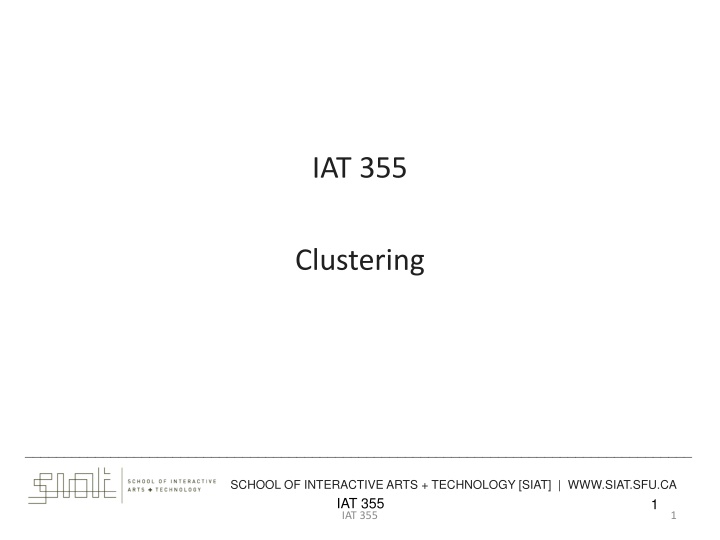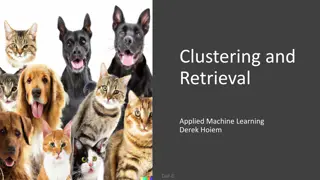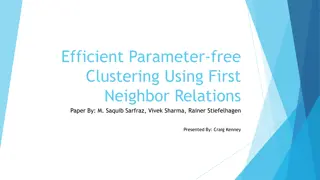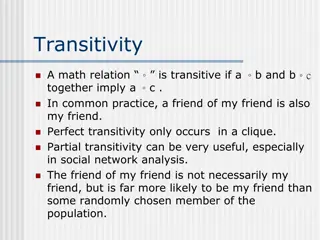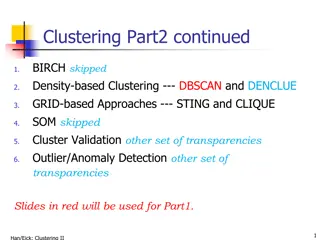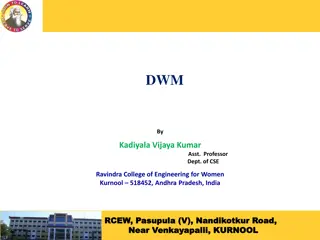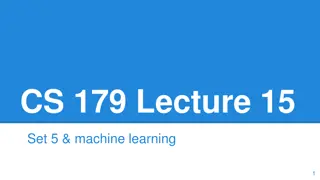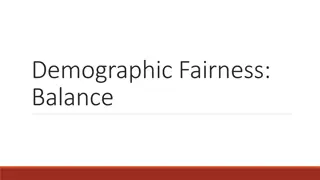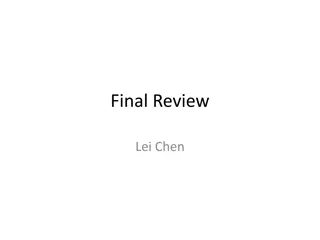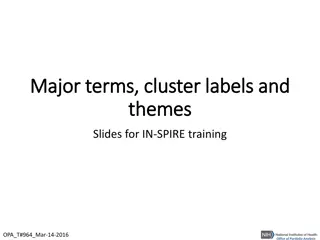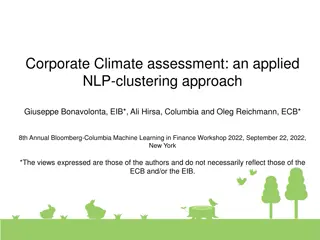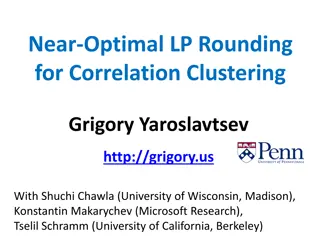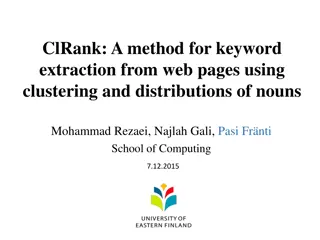Clustering in Interactive Arts & Technology
This content discusses the concept of clustering in the context of Interactive Arts & Technology, explaining the grouping of data objects based on similarities and differences. It covers topics like distance/similarity between data objects, outliers, applications of clustering, and more. The purpose, methods, and significance of clustering are explored, shedding light on its role in data analysis, visualization, and various domains such as image processing and bioinformatics.
Download Presentation

Please find below an Image/Link to download the presentation.
The content on the website is provided AS IS for your information and personal use only. It may not be sold, licensed, or shared on other websites without obtaining consent from the author.If you encounter any issues during the download, it is possible that the publisher has removed the file from their server.
You are allowed to download the files provided on this website for personal or commercial use, subject to the condition that they are used lawfully. All files are the property of their respective owners.
The content on the website is provided AS IS for your information and personal use only. It may not be sold, licensed, or shared on other websites without obtaining consent from the author.
E N D
Presentation Transcript
IAT 355 Clustering ______________________________________________________________________________________ SCHOOL OF INTERACTIVE ARTS + TECHNOLOGY [SIAT] | WWW.SIAT.SFU.CA IAT 355 1 IAT 355 1
Lecture outline Distance/Similarity between data objects Data objects as geometric data points Clustering problems and algorithms K-means K-median
What is clustering? A grouping of data objects such that the objects within a group are similar (or related) to one another and different from (or unrelated to) the objects in other groups Inter-cluster distances are maximized Intra-cluster distances are minimized
Outliers Outliers are objects that do not belong to any cluster or form clusters of very small cardinality cluster outliers In some applications we are interested in discovering outliers, not clusters (outlier analysis)
What is clustering? Clustering: the process of grouping a set of objects into classes of similar objects Documents within a cluster should be similar. Documents from different clusters should be dissimilar. The commonest form of unsupervised learning Unsupervised learning = learning from raw data, as opposed to supervised data where a classification of examples is given A common and important task that finds many applications in Info Retrieval and other places
Why do we cluster? Clustering : given a collection of data objects group them so that Similar to one another within the same cluster Dissimilar to the objects in other clusters Clustering results are used: As a stand-alone tool to get insight into data distribution Visualization of clusters may unveil important information As a preprocessing step for other algorithms Efficient indexing or compression often relies on clustering
Applications of clustering? Image Processing cluster images based on their visual content Web Cluster groups of users based on their access patterns on webpages Cluster webpages based on their content Bioinformatics Cluster similar proteins together (similarity wrt chemical structure and/or functionality etc) Many more
Yahoo! Hierarchy isnt clustering but is the kind of output you want from clustering www.yahoo.com/Science (30) agriculture biology physics CS space ... ... ... ... ... dairy botany cell AI courses crops craft magnetism HCI missions agronomy evolution forestry relativity
The clustering task Group observations into groups so that the observations belonging in the same group are similar, whereas observations in different groups are different Basic questions: What does similar mean What is a good partition of the objects? I.e., how is the quality of a solution measured How to find a good partition of the observations
Observations to cluster Real-value attributes/variables e.g., salary, height Binary attributes e.g., gender (M/F), has_cancer(T/F) Nominal (categorical) attributes e.g., religion (Christian, Muslim, Buddhist, Hindu, etc.) Ordinal/Ranked attributes e.g., military rank (soldier, sergeant, lutenant, captain, etc.) Variables of mixed types multiple attributes with various types
Observations to cluster Usually data objects consist of a set of attributes (also known as dimensions) J. Smith, 20, 200K If all d dimensions are real-valued then we can visualize each data point as points in a d-dimensional space If all d dimensions are binary then we can think of each data point as a binary vector
Distance functions The distance d(x, y) between two objects xand yis a metric if d(i, j) 0 (non-negativity) d(i, i)=0 (isolation) d(i, j)= d(j, i) (symmetry) d(i, j) d(i, h)+d(h, j) (triangular inequality) [Why do we need it?] The definitions of distance functions are usually different for real, boolean, categorical, and ordinal variables. Weights may be associated with different variables based on applications and data semantics.
Data Structures attributes/dimensions data matrix x ... x ... x Data Cases/Objects 11 1 1d ... ... ... ... ... x ... ix ... x i1 id ... ... ... ... ... x ... x ... x n1 n nd objects Distance matrix 0 d(2,1) 0 objects d(3,1 d 0 ) ) 2 , 3 ( : : : d ) 1 , n d ) 2 , n ... ( ( ... 0
Distance functions for binary vectors Jaccard similarity between binary vectors X and Y Y X Y X JSim = ( , ) X Y Jaccard distance between binary vectors X and Y Jdist(X,Y) = 1- JSim(X,Y) Q1 Q2 Q3 Q4 Q5 Q6 Example: JSim = 1/6 Jdist = 5/6 X 1 0 0 1 1 1 Y 0 1 1 0 1 0
Distance functions for real-valued vectors Lp norms or Minkowski distance: / 1 ) p / 1 p d = p p p = + + + = ( , ) | | | | ... | | ( L x y x y x y x x x y p i i 1 1 2 2 d d 1 i wherepis a positive integer If p = 1, L1is the Manhattan (or city block) distance: d = + + + = | ( , ) | | | | ... | L x y x y x y x y x y = 1 2 2 d d i i 1 1 1 i
Distance functions for real-valued vectors Ifp = 2, L2is the Euclidean distance: (| ) , ( y x y x d = + + + 2 2 2 | | | ... | | ) x y x y 1 1 2 2 d d Also one can use weighted distance: = + + + 2 2 2 ( , ) ( | | | | ... | | ) d x y w x x w x x w x y 1 1 1 2 2 2 d d d = + + + ( , ) ... d x y w x y w x y w x y 1 2 d 1 1 2 2 d d Very often Lpp is used instead of Lp (why?)
Partitioning algorithms: basic concept Construct a partition of a set of n objects into a set of k clusters Each object belongs to exactly one cluster The number of clusters k is given in advance
The k-means problem Given a set X of n points in a d-dimensional space and an integer k Task: choose a set of k points {c1, c2, ,ck} in the d-dimensional space to form clusters {C1, C2, ,Ck} such that = i 1 k ( ) 2 = C ( ) Cost L x c 2 i x C i is minimized Some special cases: k = 1, k = n
The k-means algorithm One way of solving the k-means problem Randomly pick k cluster centers {c1, ,ck} For each i, set the cluster Ci to be the set of points in X that are closer to ci than they are to cj for all i j For each i let ci be the center of cluster Ci (mean of the vectors in Ci) Repeat until convergence
K-means Thanks, Wikipedia! Feb 24, 2017 IAT 355 20
Properties of the k-means algorithm Finds a local optimum Converges often quickly (but not always) The choice of initial points can have large influence in the result
Two different K-means Clusterings 3 2.5 Original Points 2 1.5 y 1 0.5 0 -2 -1.5 -1 -0.5 0 0.5 1 1.5 2 x 3 3 2.5 2.5 2 2 1.5 1.5 y y 1 1 0.5 0.5 0 0 -2 -1.5 -1 -0.5 0 0.5 1 1.5 2 -2 -1.5 -1 -0.5 0 0.5 1 1.5 2 x x Optimal Clustering Sub-optimal Clustering
Discussion k-means algorithm Finds a local optimum Converges often quickly (but not always) The choice of initial points can have large influence Clusters of different densities Clusters of different sizes Outliers can also cause a problem (Example?)
Some alternatives to random initialization of the central points Multiple runs Helps, but probability is not on your side Select original set of points by methods other than random . E.g., pick the most distant (from each other) points as cluster centers (kmeans++ algorithm)
The k-median problem Given a set X of n points in a d-dimensional space and an integer k Task: choose a set of k points {c1,c2, ,ck} from X and form clusters {C1,C2, ,Ck} such that = i k = C ( ) ( , ) Cost L x c 1 i 1 x C i is minimized
k-means vs k-median k-Means: Choose arbitrary cluster centers ci = i 1 k ( ) 2 = C ( ) Cost L x c 2 i x C i k-Medians: Task: choose a set of k points {c1,c2, ,ck} from X and form clusters {C1,C2, ,Ck} such that = i k = C ( ) ( , ) Cost L x c 1 i 1 x C i
Text: Notion of similarity/distance Ideal: semantic similarity. Practical: term-statistical similarity We will use cosine similarity. Docs as vectors. For many algorithms, easier to think in terms of a distance (rather than similarity) between docs. We will mostly speak of Euclidean distance But real implementations use cosine similarity
Ch. 17 Hierarchical Clustering Build a tree-based hierarchical taxonomy (dendrogram) from a set of documents. animal vertebrate invertebrate fish reptile amphib. mammal worm insect crustacean One approach: recursive application of a partitional clustering algorithm.
Dendrogram: Hierarchical Clustering Clustering obtained by cutting the dendrogram at a desired level: each connected component forms a cluster. 29
Sec. 17.1 Hierarchical Agglomerative Clustering (HAC) Starts with each item in a separate cluster then repeatedly joins the closest pair of clusters, until there is only one cluster. The history of merging forms a binary tree or hierarchy. Note: the resulting clusters are still hard and induce a partition
Sec. 17.2 Closest pair of clusters Many variants to defining closest pair of clusters Single-link Similarity of the most similar (single-link) Complete-link Similarity of the furthest points, the least similar Centroid Clusters whose centroids (centers of gravity) are the most similar Average-link Average distance between pairs of elements
Sec. 17.2 Single Link Agglomerative Clustering Use maximum similarity of pairs: ) , ( c c sim j i = max , i c ( , ) sim x y x y c j Can result in long and thin clusters due to chaining effect. After merging ci and cj, the similarity of the resulting cluster to another cluster, ck, is: max( ) ), (( k j i c c c sim = ( , ), ( , )) sim c c sim c c i k j k
Sec. 17.2 Single Link Example
Sec. 17.2 Complete Link Use minimum similarity of pairs: , ( c c sim i = ) min , i c ( , ) sim x y j x y c j Makes tighter, spherical clusters that are typically preferable. After merging ci and cj, the similarity of the resulting cluster to another cluster, ck, is: min( ) ), (( k j i c c c sim = ( , ), ( , )) sim c c sim c c i k j k Ci Cj Ck
Sec. 17.2 Complete Link Example
Sec. 16.3 What Is A Good Clustering? Internal criterion: A good clustering will produce high quality clusters in which: the intra-class (that is, within-cluster) similarity is high the inter-class (between clusters) similarity is low The measured quality of a clustering depends on both the item (document) representation and the similarity measure used
Sec. 16.3 External criteria for clustering quality Quality measured by its ability to discover some or all of the hidden patterns or latent classes in gold standard data Assesses a clustering with respect to ground truth requires labeled data Assume documents with C gold standard classes, while our clustering algorithms produce K clusters, 1, 2, , K with nimembers.
Purity Simple measure: purity, the ratio between the most common class in the cluster i and the size of cluster i Purity i 1 ( = ) max ( ) n j C i j ij n Biased because having n clusters maximizes purity Others are entropy of classes in clusters (or mutual information between classes and clusters)
Sec. 16.3 Purity example Cluster I (Red) Cluster II (Blue) Cluster III (Green) Cluster I: Purity = 1/6 (max(5, 1, 0)) = 5/6 Cluster II: Purity = 1/6 (max(1, 4, 1)) = 4/6 Cluster III: Purity = 1/5 (max(2, 0, 3)) = 3/5
Sec. 16.3 Rand Index measures between pair decisions. Here RI = 0.68 Different Clusters in clustering Same Cluster in clustering Number of points Same class in ground truth 20 24 Different classes in ground truth 20 72
Sec. 16.3 Rand index + A D = RI + + + A B C D
Thanks to: Evimaria Terzi, Boston University Pandu Nayak and Prabhakar Raghavan, Stanford University
